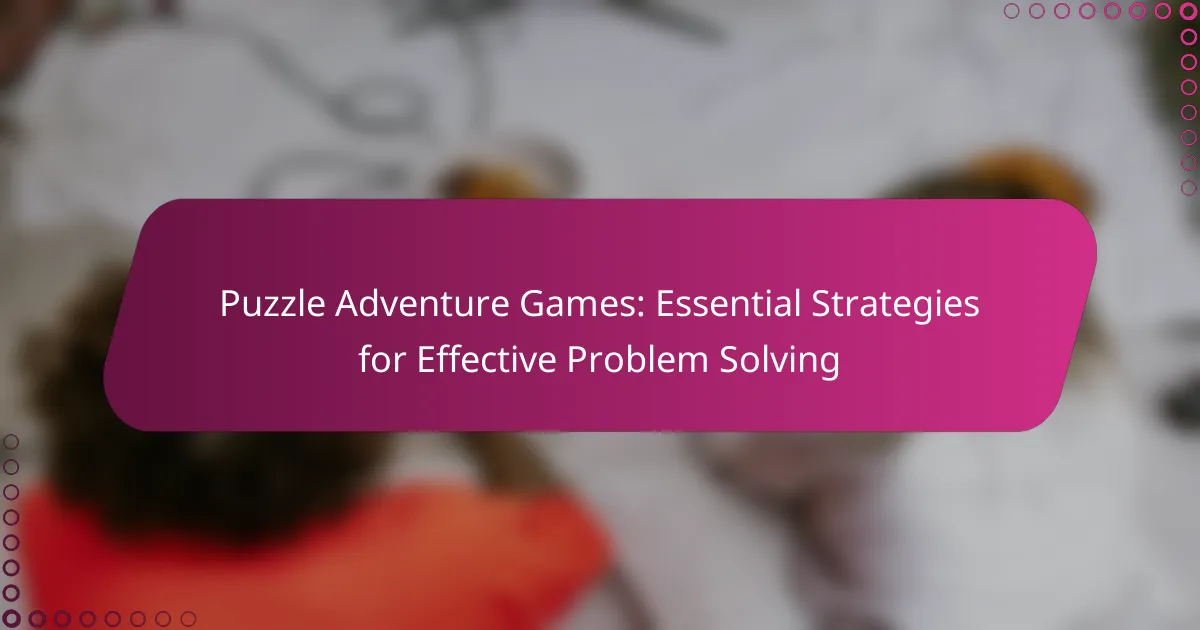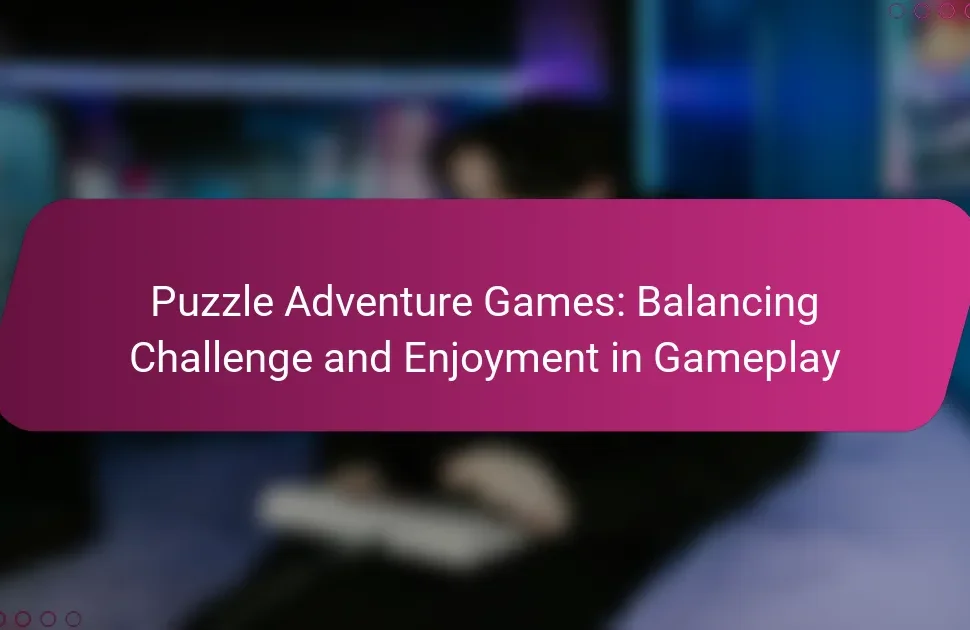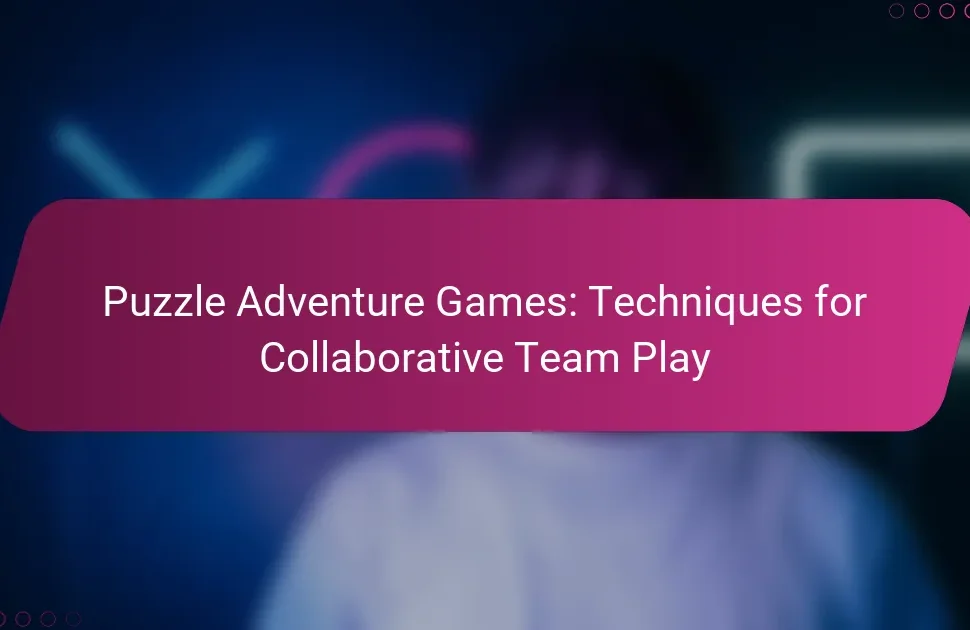Mastering puzzle adventure games enhances problem-solving skills and critical thinking. Players engage with intricate puzzles, explore immersive environments, and utilize collaborative strategies. Key approaches include analyzing surroundings, breaking down challenges, and experimenting with solutions. Cultural influences also shape puzzle design and player strategies, enriching the overall gaming experience.

What are the key characteristics of puzzle adventure games?
Puzzle adventure games are defined by their engaging narratives, intricate puzzles, and immersive environments. Key characteristics include exploration, problem-solving, and interactive storytelling. Players often navigate through richly designed worlds, collecting items and clues that aid in overcoming challenges. Unique attributes involve the combination of visual art styles and sound design that enhance the gaming experience. Rarely, these games may include time-based puzzles or environmental storytelling elements that deepen player engagement.
How do gameplay mechanics influence problem-solving?
Gameplay mechanics significantly enhance problem-solving by providing structured challenges and feedback loops. These mechanics engage players in critical thinking and strategic planning.
Puzzle adventure games often utilize mechanics like item collection, environmental interactions, and logic puzzles. These elements encourage players to analyze their surroundings and apply creative solutions. For instance, combining items to unlock new areas fosters experimentation.
Additionally, time constraints or limited resources can heighten the urgency of decision-making. This pressure often leads to innovative problem-solving strategies as players adapt to overcome obstacles.
The iterative nature of gameplay mechanics allows players to learn from failures. Each attempt provides insights, refining their approach and enhancing overall problem-solving skills.
Which narrative elements enhance player engagement?
Narrative elements that enhance player engagement include compelling storytelling, relatable characters, immersive environments, and challenging puzzles. These elements create emotional investment, driving players to explore and solve problems. Strong narratives provide context for challenges, while well-developed characters foster connections. Immersive environments enhance the sense of presence, making the gameplay experience more captivating. Finally, challenging puzzles stimulate critical thinking, keeping players engaged and motivated.
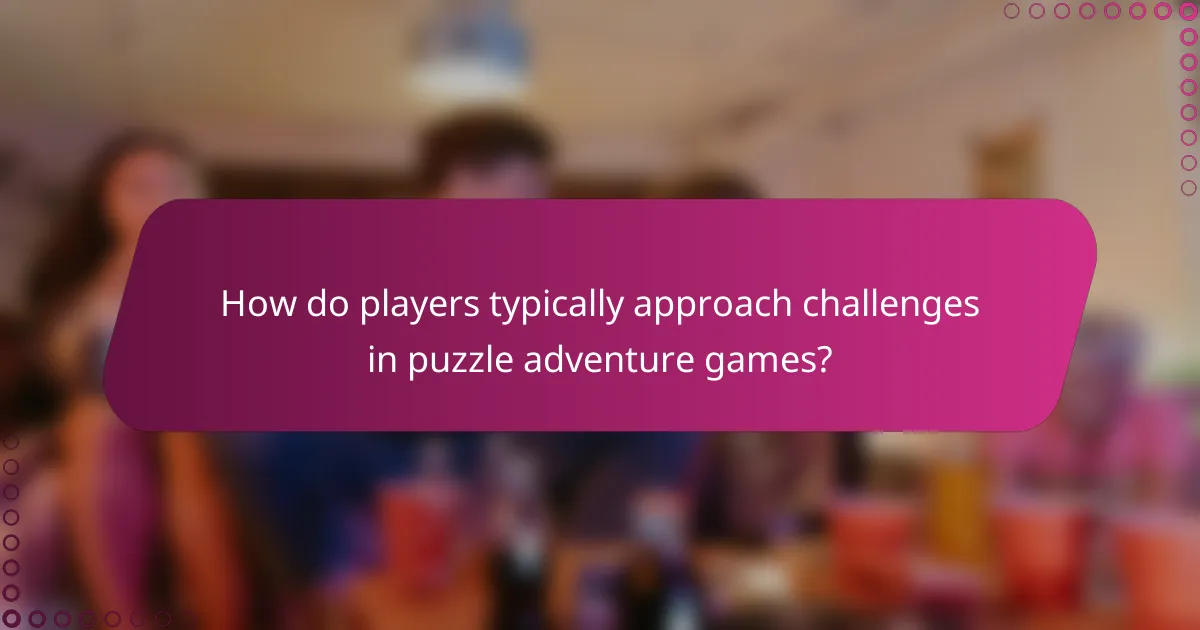
How do players typically approach challenges in puzzle adventure games?
Players typically approach challenges in puzzle adventure games by employing a mix of exploration, critical thinking, and collaboration. They analyze their surroundings to gather clues and items, often experimenting with different combinations to solve puzzles. Effective players also utilize trial and error, learning from mistakes to refine their strategies. Additionally, they may seek hints or collaborate with others to overcome particularly challenging obstacles. This multifaceted approach enhances problem-solving efficiency and enriches the gaming experience.
What strategies do players use to analyze puzzles?
Players use various strategies to analyze puzzles in adventure games. They often break down puzzles into smaller components, identify patterns, and utilize trial and error. Observing the environment for clues and collaborating with other players enhances problem-solving. Critical thinking and persistence are essential for overcoming challenges.
How can collaboration enhance problem-solving in multiplayer settings?
Collaboration enhances problem-solving in multiplayer settings by leveraging diverse perspectives and skills. Team members can share unique insights, leading to innovative solutions. Effective communication fosters trust and encourages experimentation, which is crucial in puzzle adventure games. Players can combine their strengths to tackle complex challenges, resulting in a more engaging experience. Additionally, collaborative problem-solving promotes a sense of achievement as players work together, enhancing overall enjoyment and motivation.
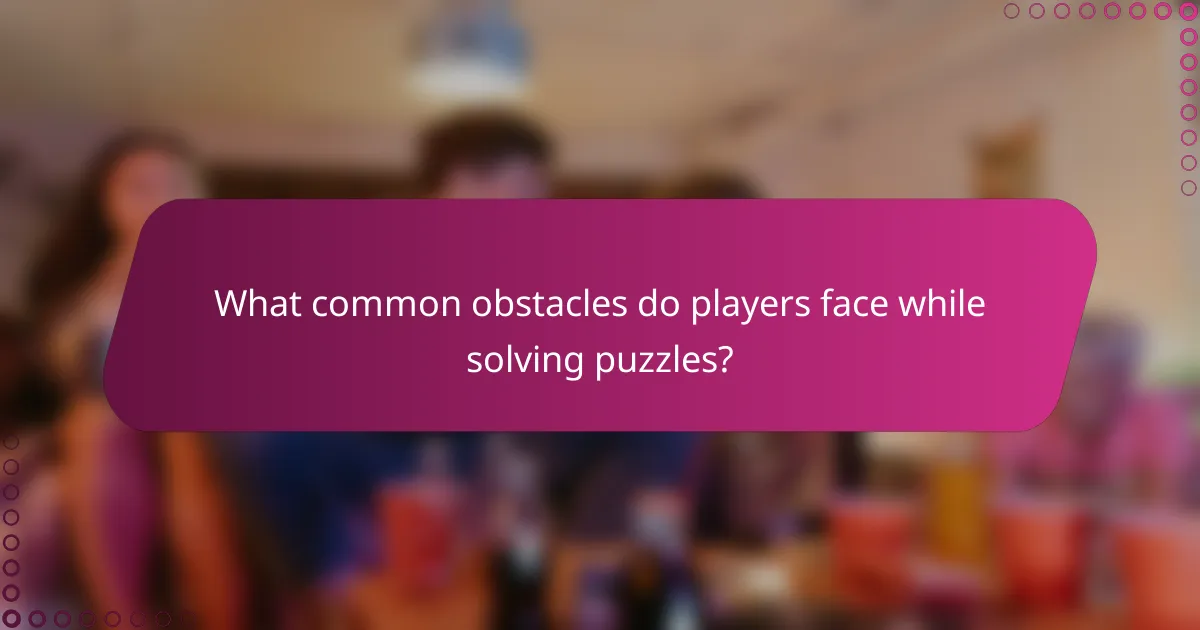
What common obstacles do players face while solving puzzles?
Players often face obstacles like complex puzzles, time constraints, and limited clues. These challenges can hinder progress and lead to frustration. Additionally, players may struggle with collaboration in multiplayer settings, where communication is vital. Adapting strategies to address these obstacles enhances problem-solving effectiveness in puzzle adventure games.
How do frustration and motivation impact gameplay experience?
Frustration can hinder gameplay experience in puzzle adventure games, while motivation enhances engagement and problem-solving. Players often encounter challenging puzzles that can lead to feelings of frustration. This emotional response can diminish enjoyment and lead to disengagement. Conversely, motivation drives players to persist through difficulties, fostering a sense of achievement upon solving puzzles. Balancing these emotions is crucial for a fulfilling gameplay experience. Effective strategies include setting achievable goals, providing hints, and creating a supportive game environment that encourages exploration and learning.
What are the effects of time constraints on problem-solving effectiveness?
Time constraints can negatively impact problem-solving effectiveness in puzzle adventure games. Players may rush decisions, leading to mistakes or overlooked solutions. Stress from time pressure can hinder creativity and critical thinking, reducing overall performance. It’s essential to manage time wisely to enhance strategic gameplay and improve outcomes.

Which tools and resources can aid in effective problem-solving?
Puzzle adventure games can enhance problem-solving skills through engaging mechanics and strategies. Key tools and resources include interactive puzzles, storyline-driven quests, and collaborative gameplay. These elements foster critical thinking, creativity, and teamwork.
1. Interactive puzzles: These stimulate cognitive functions and encourage logical reasoning.
2. Storyline-driven quests: They immerse players in narratives, enhancing engagement and problem-solving motivation.
3. Collaborative gameplay: Working with others promotes communication and diverse perspectives, improving solutions.
Utilizing these tools effectively can lead to improved problem-solving abilities in real-life scenarios.
What role do hints and clues play in puzzle adventure games?
Hints and clues are vital in puzzle adventure games as they guide players through challenges. They enhance problem-solving by providing essential information without revealing solutions outright. This encourages critical thinking and exploration. Effective use of hints can balance difficulty, ensuring players remain engaged while progressing through the game.
How can walkthroughs and guides improve gameplay experience?
Walkthroughs and guides significantly enhance gameplay experience by providing players with valuable insights and strategies. They help players navigate complex puzzles, understand game mechanics, and discover hidden secrets. This support reduces frustration and promotes a sense of accomplishment. As a result, players can focus more on enjoyment rather than getting stuck.
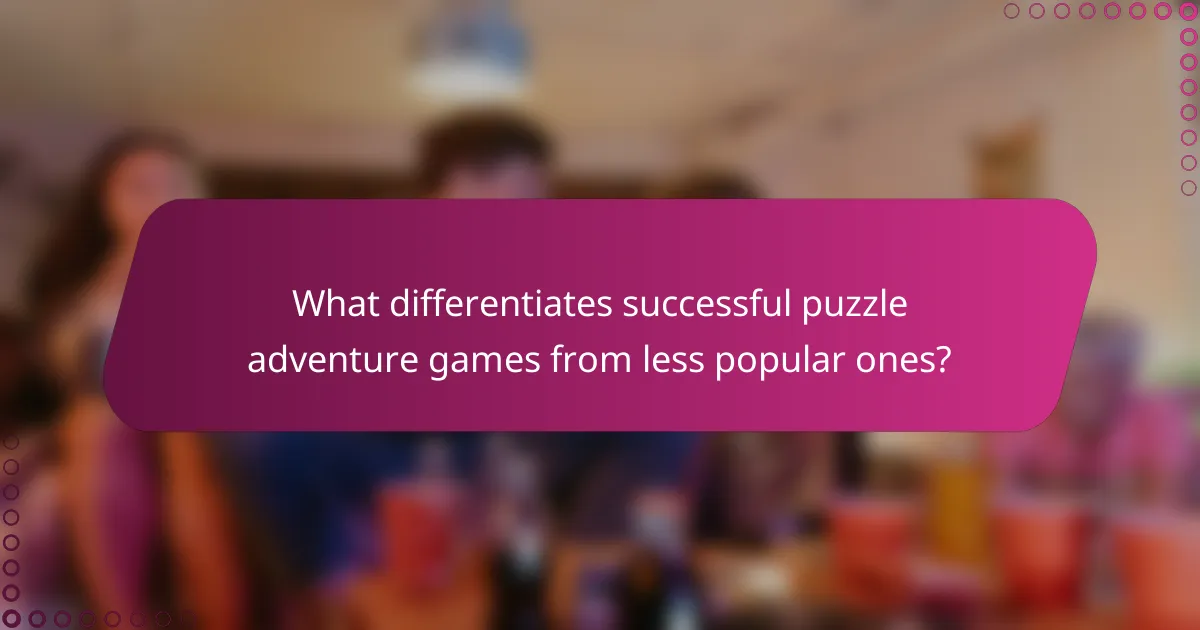
What differentiates successful puzzle adventure games from less popular ones?
Successful puzzle adventure games often feature engaging narratives, innovative mechanics, and well-designed puzzles. These elements create immersive experiences that resonate with players, leading to higher popularity. Strong character development and a balanced difficulty curve also contribute significantly to a game’s success. Games that encourage exploration and provide rewarding feedback tend to attract and retain players more effectively.
How do innovative design elements contribute to player satisfaction?
Innovative design elements significantly enhance player satisfaction in puzzle adventure games by creating immersive experiences. Engaging visuals, intuitive interfaces, and dynamic soundscapes contribute to a captivating atmosphere. Unique attributes like adaptive difficulty levels cater to diverse skill sets, ensuring players remain challenged yet not frustrated. Root attributes, such as coherent storylines and logical puzzles, foster a sense of achievement. As a result, players feel more invested in the game, leading to prolonged engagement and enjoyment.
Which unique puzzles have gained acclaim in the gaming community?
Unique puzzles that have gained acclaim in the gaming community include titles like “The Witness,” “Portal,” and “Baba Is You.” These games are celebrated for their innovative mechanics and challenging designs. “The Witness” offers a vast open world filled with intricate line puzzles, fostering exploration and critical thinking. “Portal” combines physics-based challenges with a compelling narrative, while “Baba Is You” introduces a unique rule-altering mechanic that allows players to manipulate the game’s fundamental logic. Each of these games exemplifies creativity and depth, contributing significantly to the puzzle adventure genre.

How do cultural influences shape puzzle design and player strategies?
Cultural influences significantly shape puzzle design and player strategies by integrating local themes and problem-solving approaches. Designers often draw from cultural narratives, symbols, and traditions, creating puzzles that resonate with players’ backgrounds.
For instance, puzzles in Japanese games may incorporate elements of Zen philosophy, emphasizing minimalism and patience. In contrast, Western games might focus on narrative complexity and character development. These cultural nuances affect how players approach challenges, influencing their strategies and problem-solving methods.
Moreover, cultural context can dictate the types of logic and reasoning favored in puzzles. Players from different regions may prioritize collaborative problem-solving or individual exploration based on their cultural upbringing. This diversity enriches the gaming experience and encourages varied strategies, making puzzle adventure games more engaging.
What regional preferences exist in puzzle adventure game mechanics?
Regional preferences in puzzle adventure game mechanics vary significantly, reflecting cultural influences and player expectations. For instance, Western players often favor complex narratives and character development, while Eastern players may prioritize gameplay mechanics and puzzle difficulty.
Cultural context shapes preferences. In Japan, puzzle adventure games frequently incorporate visual storytelling and intricate art styles, appealing to local aesthetics. Conversely, in the U.S. and Europe, players might prefer more straightforward gameplay with an emphasis on exploration and problem-solving.
Player demographics also influence mechanics. Younger audiences may enjoy fast-paced puzzles with immediate feedback, while older players might appreciate slower, more contemplative challenges. Additionally, regional market trends can dictate popular themes, such as mythology or folklore, which resonate with local players.
As a result, game developers often tailor their mechanics to meet these diverse regional preferences, ensuring broader appeal and engagement across different markets.
How does storytelling vary across different cultures in gaming?
Storytelling in gaming varies significantly across cultures, reflecting unique values and traditions. Different cultures prioritize distinct narrative elements, such as character development, plot structure, and moral lessons. For instance, Western storytelling often emphasizes individualism and conflict resolution, while Eastern narratives may focus on harmony and community. Cultural symbols and folklore also shape game narratives, creating diverse experiences that resonate with players. Additionally, puzzle adventure games incorporate these storytelling elements, enhancing problem-solving through culturally rich contexts.
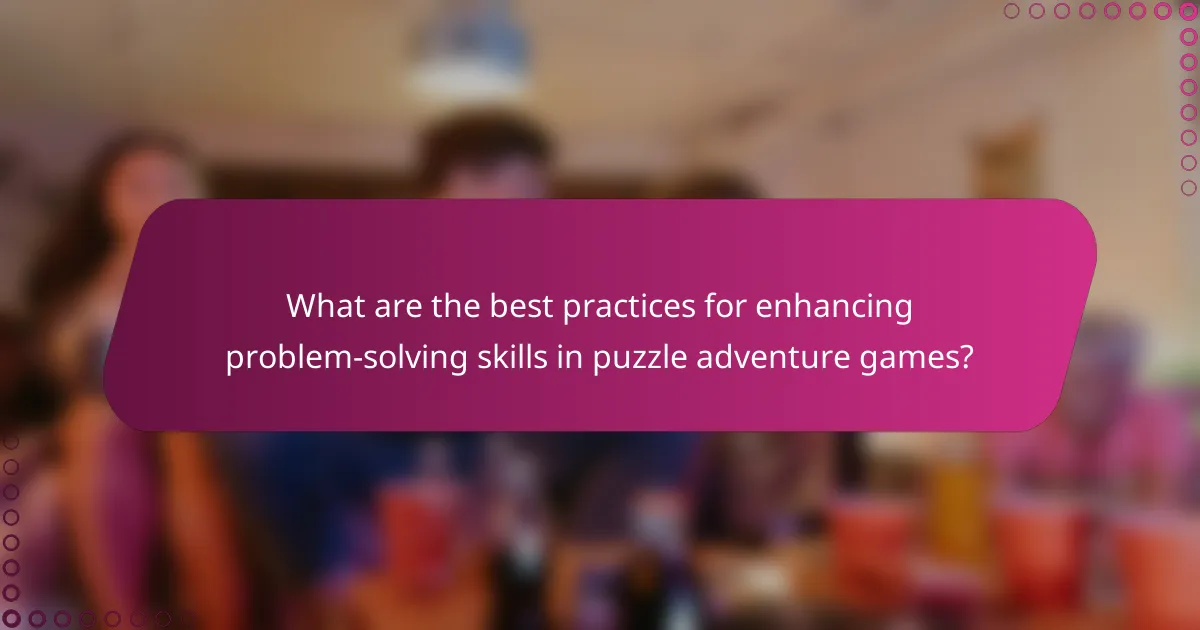
What are the best practices for enhancing problem-solving skills in puzzle adventure games?
To enhance problem-solving skills in puzzle adventure games, players should adopt strategic approaches. Focus on critical thinking, practice pattern recognition, and collaborate with others to brainstorm solutions.
1. Analyze the environment: Examine clues and items thoroughly.
2. Break down challenges: Divide complex puzzles into manageable parts.
3. Experiment with solutions: Test different approaches without fear of failure.
4. Utilize hints wisely: Seek assistance when stuck, but avoid over-reliance.
5. Reflect on past puzzles: Learn from previous experiences to improve future performance.
These practices foster a deeper understanding of game mechanics and enhance overall enjoyment.
Which techniques can players adopt to improve their analytical thinking?
Players can adopt several techniques to enhance their analytical thinking in puzzle adventure games. Engaging in pattern recognition helps identify solutions. Breaking down complex problems into smaller parts simplifies analysis. Additionally, practicing foresight by anticipating consequences improves decision-making. Collaborating with others can provide new perspectives, while maintaining a reflective mindset allows for learning from past mistakes.
What common mistakes should players avoid during gameplay?
Players should avoid common mistakes like rushing through puzzles, ignoring clues, and failing to communicate in multiplayer settings. These errors can hinder progress and diminish enjoyment.
1. Rushing: Take time to analyze each puzzle. Quick decisions often lead to mistakes.
2. Ignoring clues: Pay attention to hints and environmental cues. They are designed to assist.
3. Poor communication: In multiplayer games, discuss strategies and findings with teammates.
4. Overlooking inventory: Regularly check items collected, as they may be crucial for solving puzzles.
5. Not experimenting: Try different approaches to puzzles. Sometimes unconventional methods yield solutions.
How can players balance exploration and puzzle-solving effectively?
Players can balance exploration and puzzle-solving by prioritizing observation and strategic planning. Regularly assess surroundings for clues while maintaining focus on objectives.
Engaging with the environment enhances problem-solving skills. Identify patterns and connections in the game world. Use these insights to inform puzzle strategies.
Time management is crucial. Allocate specific periods for exploration and puzzle-solving. This prevents frustration and promotes steady progress.
Collaboration with other players can provide new perspectives. Discussing challenges may reveal overlooked details and solutions.
